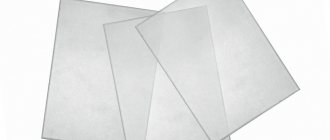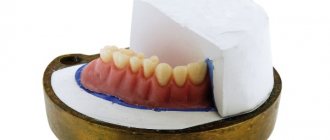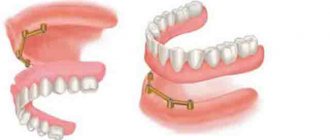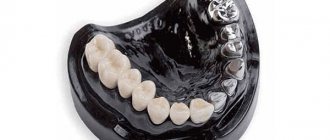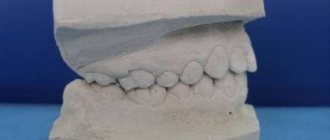What is the secret of the popularity of acrylic plastics
Today, plastics are no longer used for veneering crowns and bridges as widely as before. Porcelain and modern composite materials will gradually replace cheap plastic, but will not completely replace it due to economic benefits. The properties of acrylic plastics were overestimated immediately after the material appeared on the market. Over time, a harmful effect on the mucous membrane and low strength of acrylic were discovered.
Despite the development of polymer technology, over the past few decades, materials based on derivatives of methacrylic and acrylic acid have held the lead in orthopedic dentistry. Acrylic polymers are attractive due to their low toxicity and ease of processing - at low pressure and relatively low temperature. These properties bring them to a high competitive level.
The latest development - Vertex
Not long ago, the semi-rigid Vertex design was developed, which has already received many positive reviews. The following features can be highlighted:
- The material is characterized by high density and exceptional smoothness.
- The chewing load is evenly distributed on the upper and lower jaws of the product.
- The design is resistant to temperature changes and retains its shape even when eating very hot food.
- The prosthesis does not change color and does not absorb any odors.
- The product does not emit harmful substances and does not contain monomers.
- The models are very resistant to mechanical damage.
Vertex models look like this:
Acrylic
Partially removable
Partially removable
Telescopic and on implants
You can make the design in any of 12 shades:
Classification of polymers
Polymers used in prosthetic dentistry belong to one of three groups. Each of them is subject to different hygienic, toxicological, aesthetic, and technological requirements.
- Basic, or basic polymers in dentistry are used for the manufacture of artificial teeth and bases for removable dentures.
- Auxiliary - needed for impressions, molding and modeling.
- Clinical polymers include sealants, restoratives, and adhesives.
Manufacturing process
The production of acrylic structures is characterized by maximum simplicity. The following stages of product creation can be distinguished:
- In dentistry, the patient is diagnosed with the oral cavity and assessed which prosthetic option will be most suitable.
- If necessary, treatment is carried out. You cannot install a removable structure if there are inflammations or diseases in the mouth.
- The doctor makes a cast of the jaw, which is used to create a plaster model, and then the product itself from acrylic.
- The patient tries on the model. If necessary, it is corrected.
The process of making a prosthesis takes a maximum of 7 days, but the adaptation time to it can last up to 30 days. If a person experiences discomfort, feels strong friction, or feels like the model is not made to fit, you should consult a doctor.
Water resistance and water absorption of polymers
Water resistance is the ability of polymers to retain their properties under prolonged exposure to water. If water gets inside the polymer, it swells, its shape is distorted, and its strength indicators suffer. Moisture resistance is resistance to humid air. Due to absorption, water vapor also causes swelling of hydrophilic materials. However, more often moisture accumulates in the surface layer due to adsorption, penetrating into microcracks.
The water resistance of the polymer is characterized by water absorption. This parameter indicates the amount of water that the material is able to absorb when kept at a temperature of 18-22 ° C for 23 hours. Due to water absorption, the geometric shape of the prosthesis base changes, and the mechanical properties deteriorate. The higher the water absorption, the more susceptible the polymer is to the penetration of microorganisms.
The presence of sorption water in the polymer sharply reduces its strength, hardness, rigidity, and indentation resistance. The polymer loses soluble substances, so its properties change.
Proper care of the prosthesis
Artificial teeth require the same careful care as natural teeth. The better you take care of them, the longer they will last. The following recommendations must be followed:
- Clean your dentures twice a day with a brush and toothpaste.
- Rinse your mouth after each meal or rinse the product under regular clean water.
- During the first 14 days of adaptation, it is best not to use the product at night. Thanks to this, the tissues will be able to quickly adapt to a foreign object.
- If the patient plans to remove the removable jaw during the night's rest, a special denture solution and a suitable container must be used. This will allow the product to be thoroughly disinfected.
- It is worth limiting the consumption of foods with a hard and sticky consistency. Such products can cause the structure in the mouth to shift and even damage it.
- It is necessary to treat this delicate item with care and try not to drop it.
- It is imperative to visit a doctor once every 6 months. Regular inspection will allow you to identify defects and problems in a timely manner.
- It is strictly forbidden to carry out structural repairs with your own hands.
Acrylic dentures are a convenient and affordable solution for restoring dentition. Such products rarely cause side effects and are not felt in the mouth. It is important to understand that discomfort during the adaptation period is a natural reaction of the body. The discomfort will pass when the oral cavity gets used to the jaw. You should also remember the importance of careful hygiene and regularly disinfect your prosthesis. Then the product will serve for a long time.
What is residual monomer
One of the disadvantages of acrylic base polymers is residual monomer. We are talking about the part of the monomer that did not enter into the polymerization reaction. The amount of residual monomer in the polymer depends on the nature of the initiator, the time and temperature of polymerization. Monomers can have a harmful effect on the body, cause inflammation of the prosthetic bed and various allergic reactions, so it is necessary to achieve a minimum content of it in the denture.
In hot-curing plastics there is 0.5% residual monomer, in self-hardening ones its amount can reach 3-5%. The substance has a negative effect on the strength of the material. When this value exceeds 3%, a sharp decrease in strength is observed, water-oil-alcohol absorption increases, and aging accelerates.
What is good about eco-prosthesis?
- Invisibility to others. Metal clasps on acrylic dentures, visible when smiling, have been replaced with special dentaalveolar (gingival) clasps matching the color of the gums. No one will know that you wear a removable denture! Compare:
- Many patients note that eco dentures are thinner than classic acrylic dentures, take up less space in the mouth, are more comfortable to wear, and are easier to use.
- Another advantage of the eco-prosthesis is its high strength. It is almost impossible to break such a prosthesis.
- Hypoallergenic. For people with an allergic reaction to plastic and metal, this is practically the only possible type of removable prosthetics.
metal clasp:
periodontal clasp:
Heat resistance and thermal conductivity
Heat resistance is understood as the maximum operating temperature of a polymer at which the material can withstand a certain load for a given time, maintaining its geometric shape after cooling. Operating temperatures for the use of plastics, grinding and polishing must occur within the heat resistance range, otherwise mechanical changes will occur.
Thermal conductivity, or the ability to transfer heat, depends on the polymer matrix and filler. The indicator increases with increasing molecular weight. These two thermal characteristics affect the shrinkage of the material, the occurrence of defects in the production of prostheses, and comfort during use.
Various physical and chemical processes affect the aging process of polymers. Destruction in them occurs due to exposure to biological media, mechanical stress and strong temperature changes. Destruction causes fragility of dental dentures and loss of their functionality.
Advantages and disadvantages
If you believe the reviews about acrylic removable dentures, then such designs have many advantages. These include:
- Minimal contraindications compared to other prosthetic methods.
- Natural appearance of the structure.
- Easy to use. The model can be easily removed and put on.
- The product is produced quite quickly. Sometimes production and installation can be completed in as little as one day.
- Easy to care for.
- Even distribution of the load when chewing.
- Durability and reliability.
- The ability to quickly repair the product in case of breakdown.
- Lightness of design.
- Affordable price.
- If necessary, such a prosthesis can be made even for a child.
However, any product has not only pros, but also cons. Acrylic dentures are no exception. Their disadvantages include the following factors:
- Due to the fact that the material is quite hard and puts pressure on the soft tissues of the oral cavity, the gums can be damaged. A similar nuisance can happen in the first 14 days, since at this time one is getting used to a foreign object.
- If there are real supporting chewing units or crowns under the denture, they may begin to wear off when rubbing against the artificial jaw.
- When worn for a long time, acrylic begins to release harmful substances. Although toxins appear in small quantities, allergies or even toxic poisoning are still possible.
- The prosthesis material has a porous structure, so bacteria can form on it. In the absence of high-quality hygiene, this will lead to the occurrence of inflammatory processes. Bacteria also causes an unpleasant odor.
- If the product is fixed only due to the suction effect, then sometimes it can jump off, which causes discomfort during use.
New trends in the production of base polymers
In the last few years, there has been a tendency to introduce aesthetic fibers into the structure of hot-curing base polymers. They look more advantageous, but they are inferior to the standard ones in terms of physical and mechanical properties. “Veins” in the structure of polymers lead to the formation of microvoids and reduce the density of the material. Oxygen in microvoids increases the number of monomers. Therefore, such polymers with improved aesthetic characteristics should be used only when indicated - in rare cases.
Despite certain disadvantages, acrylic plastics remain the most common material for the production of removable denture bases. Their main advantages are low price, manufacturability and lack of need for expensive equipment.
Design Features
The structure is made of acrylic plastic. This material looks natural and is well compatible with oral tissues. A qualified specialist is able to select a model that will fully match the shade of the gums and teeth.
Depending on the size of the prosthesis, its base can cover the entire gum or part of it. The artificial dentition is securely attached to the base and exactly replicates natural teeth. This model is very comfortable to wear, does not give a person any unpleasant sensations, and can be removed at night or left in the mouth until the morning.
Photos before and after installation
With careful care, the structure can last from 3 to 5 years. But if you do not pay due attention to cleaning the dental product, drop it on the floor, or often eat hard food, then this will negatively affect its service life.
There are many types of acrylic dentures. Depending on how many teeth need to be replaced and what installation method will be used, there are several types of construction:
- Full. Indicated in the absence of all teeth.
- Conditionally removable. Such models are a temporary option placed on implants. In the future they will be replaced with other prostheses.
- Partial. They replace only part of the lost teeth. Installed on natural support units. Hooks and clasps are used for fixation.
- Butterfly dentures. They are used to replace one or more teeth and are attached to adjacent healthy ones. A very comfortable design that can be left on during the night.
Full
Full
Partial
Butterfly for 2 teeth
Is it possible to repair a prosthesis at home?
Most damage to acrylic dentures can be repaired without the expense of producing new structures.
Repair is required in situations such as:
- an artificial tooth is built in place of the removed supporting tooth;
- if an artificial dental organ falls out or is chipped, it is replaced with a new one;
- the lock that secures the prosthesis is attached to the supporting teeth has failed;
- the prosthesis does not fit well to the gum, and the base needs to be adjusted;
- the base is broken, it is repaired, or replaced if it is severely damaged.
Dentures have their own warranty period. Most often it is determined in one year.
An acrylic denture accidentally dropped into a sink or on the floor may crack or break. This can also happen when certain areas are under heavy load during chewing.
The patient can repair a removable denture on his own, but not always. Breakage of the clasp (attached hook) cannot be done by a person without special skills, so in such a situation you need to contact a specialist.
Some patients try to glue a broken prosthesis with conventional adhesives (Moment, PVA, epoxy glue), which is strictly prohibited. After all, such compositions may contain toxic substances that are harmful to the human body and can lead to dermatitis or eczema.
When deciding to repair a prosthesis yourself, it is important to know the following:
- If you glue a structure with PVA, moisture can lead to its softening and rapid divergence of the seam.
- A rubber prosthesis is also not suitable for an acrylic prosthesis. The glue seam should not be elastic, but rather its rigidity is important. If a nylon prosthesis is glued together, the situation is the opposite.
- Using a large amount of hardener relative to the epoxy resin runs the risk of severe irritation of soft tissues from the alkaline amines contained in the hardener.
- Cyanoacrylate super glue can sometimes be used to temporarily repair acrylic dentures. It is advisable to use it when the patient has already made an appointment with a specialist for repair of the structure, but the day of the appointment will come in a few days, during which the patient does not want to go without teeth. In such a situation, super glue is the safest option relative to other types of glue. It is important to carry out gluing as carefully as possible. But the glue seam will also not last long, since it will constantly be in contact with moisture.
There are patients who tried to repair the structure by soldering it. Usually such manipulations are unsuccessful, regardless of whether the patient used polymethyl methacrylate for this.
If the clasp fits very tightly, or vice versa, too loosely, it is also better to entrust the correction of the prosthesis to a specialist. For the bravest patients who decide to do it themselves, it is recommended to use pliers for this. In this case, great caution and constant testing of the structure are important so as not to provoke the hook to break off.
The same applies if you want to avoid chafing. Some patients try to sand the surface of the base using sandpaper or a nail file.
If you are not sure that you will do it well, you should not do it. After all, you can ruin your prosthesis by trying to improve it at home. Repair and correction of a prosthesis is a matter for a specialist.
The essence of prosthetics with acrylic material
Let's look at what acrylic prostheses are and in what cases they are used.
Acrylic structures are very popular due to their low price. In addition, they are used for any age category.
Removable dentures are also made from acrylic, both completely and partially. In this way, entire rows of lost teeth in any jaw can be restored.
The material of the acrylic product is a chemically produced composite that replaced the rubber previously used for prosthetics. Acrylic is much lighter, simpler and more comfortable to wear. It can be used to make a prosthesis that matches the color of living teeth and gums as closely as possible.
Acrylic products are placed on both adults and children (for example, in order to form a correct bite when baby teeth fall out unevenly).
Acrylic structures are also used as temporary structures. This way, the oral cavity is restored more quickly after treatment of teeth and mucous membranes, removal of a dental organ, filling of canals, and so on. The temporary plastic prosthesis is then replaced with a permanent one made of a different material.
Due to its low cost, this type of prosthesis is loved by older people. Many pensioners choose them to restore their teeth and their functionality.
Cost of acrylic dentures
Acrylic products are inexpensive. Their price will be lower than other types, even if the installation is highly complex. The quality is also not bad.
The cost of acrylic structures is 10,000 - 19,000 rubles. At the same time, the price decreases as the number of teeth that need to be restored in this way increases.
| MULTISTOM, Moscow, st. Shirokaya house 3 k.3 | from 12,000 rub. |
| Koronka Moscow, Parkovaya 51/2 building | 12000-20000 rub. |
| Dental center on Parkovaya, Moscow, Pekhotny lane. 11a | 15000 rub. |
| Aesculapius Moscow, Tverskaya - Yamskaya 18 | 12600 rub. |
| Tooth. ru Moscow, Khutorskaya 49/2 | 17500 rub. |
Acrylic or nylon: which is better?
| Criterion | Acrylic | Nylon |
| Material hardness | Material is solid | The material is soft, following the contours of the gums and palate |
| Ability to maintain shape | Retains its original shape for a long time | Deformed due to the softness of the material |
| Porosity | The structure is porous, as a result of which bacteria may accumulate in the pores, plaque formation, and an unpleasant odor may occur. | The structure is non-porous, so plaque and odor are practically not formed |
| Toxicity | Over time, toxic substances may be released | Non-toxic material |
| Fixation | Using special adhesives or clasps | Most often using suction |
| Price | Available | High enough |
Thus, both materials have both disadvantages and advantages, so it is better to make a choice in favor of one of them with the help of a qualified orthopedist who can take into account individual factors.
Nylon construction | Acrylic construction |
| Thanks to the elastic frame, the product adheres to the gum as closely as possible. | The material is quite hard. |
| Due to its high plasticity, the product may deform over time. | The shape of the prosthesis is retained for a long time due to the non-plasticity of the material. |
| The material is non-porous and resists the absorption of odors and plaque accumulation. | The structure of the material is porous. Plaque can accumulate, causing an unpleasant odor and sometimes an inflammatory process. |
| The material is non-toxic. | Some time after installation it may release harmful substances. |
| Quite a high cost. | Affordable price. |
| Do not use glue for fixation. | It is allowed to use glue to improve fixation. |
